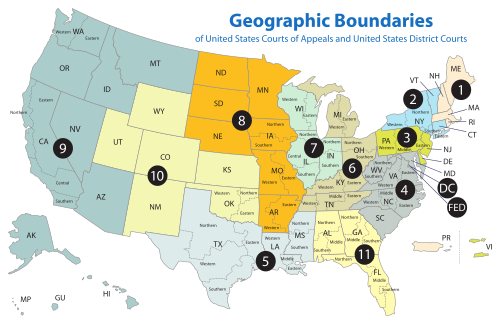List of former United States district courts
Every change to the divisions and boundaries of these courts is effected by an act of the United States Congress, and for each such action, the statutory reference is identified.[5][6] The court was subdivided into Eastern and the Western Districts on March 3, 1851, by 9 Stat. 594.Erskine Mayo Ross was appointed Judge of the new Southern District and served until his promotion to the Circuit Judgeship, when he was succeeded by Olin Wellborn.On the same day that Florida was admitted as a state, March 3, 1845, Congress enacted legislation creating the United States District Court for the District of Florida, 5 Stat. 788.[12][19] The act established a single office for a judge to preside over the court.In 1837, Congress created the United States Court of Appeals for the Seventh Circuit, placing it in Chicago, Illinois and giving it jurisdiction over the District of Illinois, 5 Stat. 176.It was later eliminated in a reorganization on October 2, 1978, which replaced it with a Central District, 92 Stat.[20][32] On February 13, 1845, Louisiana was reorganized into a single District with one judgeship, by 5 Stat.507, Louisiana was for a third time divided into Eastern and the Western Districts, with one judgeship authorized for each.[32] During the course of its frequent subdivisions and reunifications, four judges served as judge of the District of Louisiana: Dominic Augustin Hall, (1812–1820), John Dick, (1821–1823), Theodore Howard McCaleb (1845–1849), and Edward Henry Durell (1866–1874).He was shortly thereafter reappointed to the same seat on the District Court, which had remained vacant in his absence.Due to the so-called "Toledo War", a boundary dispute with Ohio, Michigan did not become a state of the Union until January 26, 1837.[1][38] It existed for over twenty years, and was subdivided into Northern and Southern Districts on June 18, 1838, by 5 Stat.[12][41] However, an act of Congress passed in 1845 and upheld by the United States Supreme Court in 1851, extending federal admiralty jurisdiction to inland waterways, resulted in a substantial increase in the number of admiralty cases arising from traffic on the Mississippi River.[42] These disputes involved "contracts of affreightment, collisions, mariners' wages, and other causes of admiralty jurisdiction", and litigants of matters arising in the port city of St. Louis found it inconvenient to travel far inland to Jefferson City for their cases to be tried.[46][47] It existed for nearly twenty-five years before, on April 9, 1814, New York was divided into Northern and Southern Districts by 3 Stat. 120.[49][50] In both instances, these districts, unlike those with geographic designations that existed in other states, were titled by the names of the cities in which the courts sat.[50] The latter combination was occasionally referred to by the cumbersome title of the United States District Court for the Albemarle, Cape Fear & Pamptico Districts of North Carolina.Judge Henry Potter's 55 years of service on this court during the period in which the state contained a single district, from April 1802 to December 1857, represents one of the longest terms ever held by a United States federal judge.On June 4, 1872, North Carolina was re-divided into two Districts, Eastern and Western, by 17 Stat. 215.[60] In 1898 the United States Supreme Court held in Barrett v. United States[63] that South Carolina legally constituted a single judicial district.Congress made a more explicit effort to subdivide the District on March 3, 1911, by 36 Stat.[4][69] The judgeship was filled by President George Washington's appointment of John McNairy.On March 3, 1837, Congress assigned the judicial district of Tennessee to the Eighth Circuit.313, Congress divided Tennessee into three districts, Eastern, Middle, and Western.On July 15, 1862, Congress reassigned appellate jurisdiction to the Sixth Circuit.Finally, on June 14, 1878, Congress authorized a separate judgeship for each district of Tennessee.[25][71] John Charles Watrous, appointed to the court by President James K. Polk in May 1846, was the only federal judge to sit for the district.[74] Just over a year later, on March 8, 1802, the Judiciary Act of 1801 was repealed and Virginia became a single District again, 2 Stat.[74] Congress again divided Virginia into Eastern and the Western Districts on February 3, 1871, by 16 Stat. 403.


United States district courtsU.S. stateUnited States CongressAlabamaNorthernSouthernMiddle DistrictTuscaloosaHuntsvilleMobileChief JudgeSenior statusCharles Tait MonroeN.D. Ala.S.D. Ala.ArkansasLouisiana PurchaseMissouri TerritoryLouisianaMissouriEasternWesternBenjamin Johnson JacksonDaniel Ringo TaylorE.D. Ark.W.D. Ark.Johnson37th parallel northSouthern District Court of New YorkSupreme Court of the United StatesMillard FillmoreOgden Hoffman Jr.Erskine Mayo RossOlin WellbornCentral FillmoreOperation of lawN.D. Cal.Hoffman, Jr.FloridaNorthern DistrictSouthern DistrictCharlotte HarborKey WestApalachicola, FloridaPensacola, FloridaIsaac H. BronsonN.D. Fla.BronsonGeorgiaJudiciary Act of 1789MiddleNathaniel Pendleton WashingtonJoseph Clay Jr.William Stephens JeffersonWilliam DaviesJeremiah La Touche CuylerJohn Cochran Nicoll Van BurenN.D. Ga.S.D. Ga.PendletonStephensDaviesCuylerNicollUnited States Attorney for the District of GeorgiaIllinoisUnited States Supreme CourtUnited States Court of Appeals for the Seventh CircuitChicagoHancockMcDonoughPeoriaWoodfordLivingstonIroquoisSpringfieldUnited States District Court for the Eastern District of IllinoisNathaniel PopeThomas DrummondN.D. Ill.DrummondIndianaBenjamin ParkeJesse Lynch HolmanElisha Mills Huntington TylerCaleb Blood Smith LincolnAlbert Smith WhiteDavid McDonaldWalter Q. Gresham GrantWilliam Allen Woods Arthur7th Cir.John Baker B. HarrisonAlbert B. Anderson T. RooseveltRobert C. Baltzell CoolidgeS.D. Ind.Thomas Whitten SlickN.D. Ind.HolmanHuntingtonMcDonaldGreshamAndersonBaltzellUnited States Attorney for the District of IndianaJohn James DyerJames M. Love PierceS.D. IowaKentuckyVirginiaJudiciary Act of 1801Harry Innes